Quality Management in Organizations: A Comprehensive Report
VerifiedAdded on 2022/10/19
|8
|1782
|475
Report
AI Summary
This report provides a comprehensive overview of Total Quality Management (TQM) within organizations. It begins by defining TQM and emphasizing its importance in achieving organizational goals and customer satisfaction. The report then explores various theories underpinning TQM, including Deming's, Crosby's, and Joseph Juran's theories, highlighting their key principles. It also addresses the challenges encountered when applying TQM, such as lack of employee commitment and inadequate planning. The importance of teamwork in TQM implementation is discussed, emphasizing its role in improving communication and coordination. The report outlines methods for monitoring and controlling TQM processes, such as customer and employee feedback. Finally, the report proposes a plan for implementing quality changes within an organization, focusing on communication, training, and employee motivation. The conclusion reiterates the benefits of TQM in enhancing organizational effectiveness and quality of goods and services.
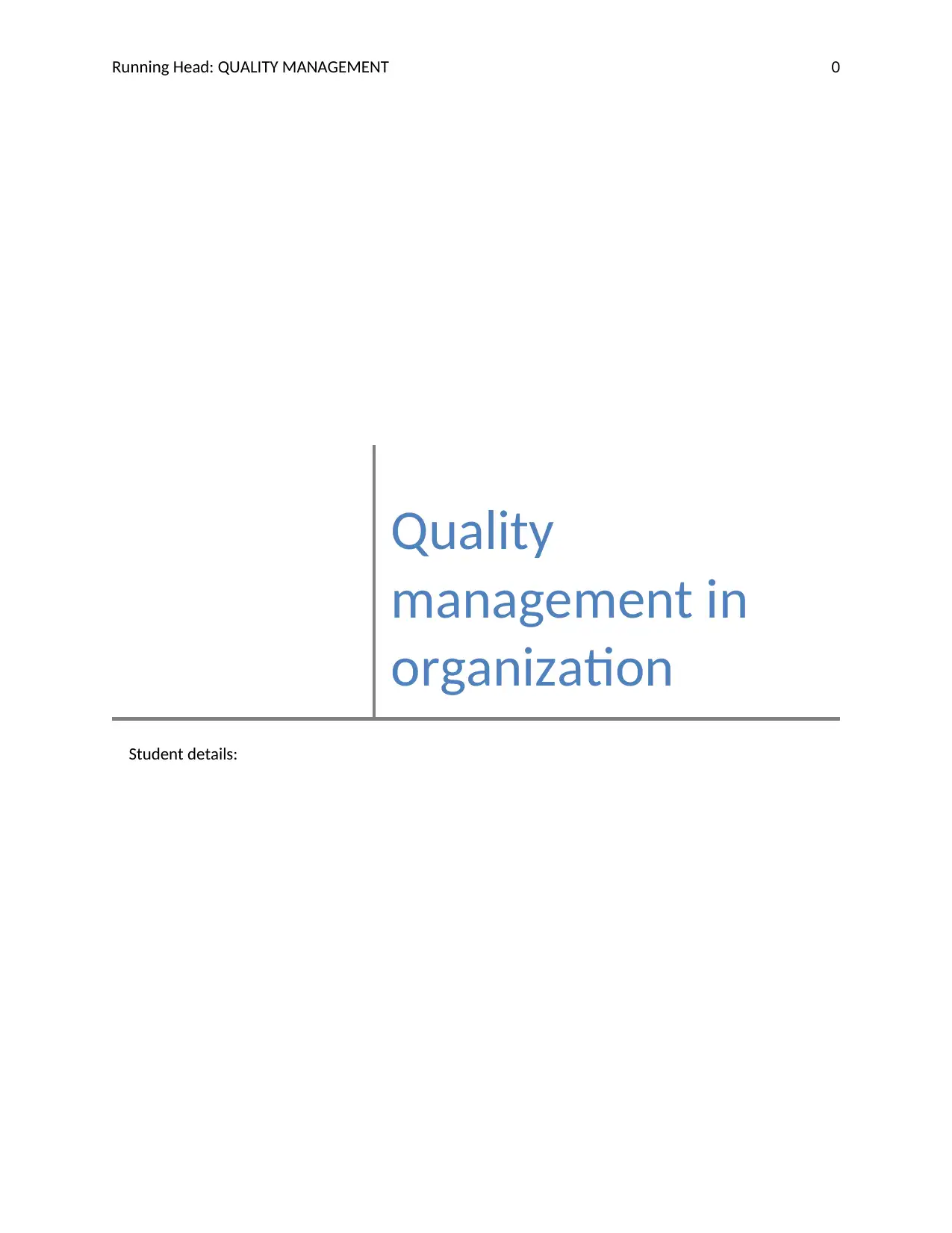
Running Head: QUALITY MANAGEMENT 0
Quality
management in
organization
Student details:
Quality
management in
organization
Student details:
Paraphrase This Document
Need a fresh take? Get an instant paraphrase of this document with our AI Paraphraser
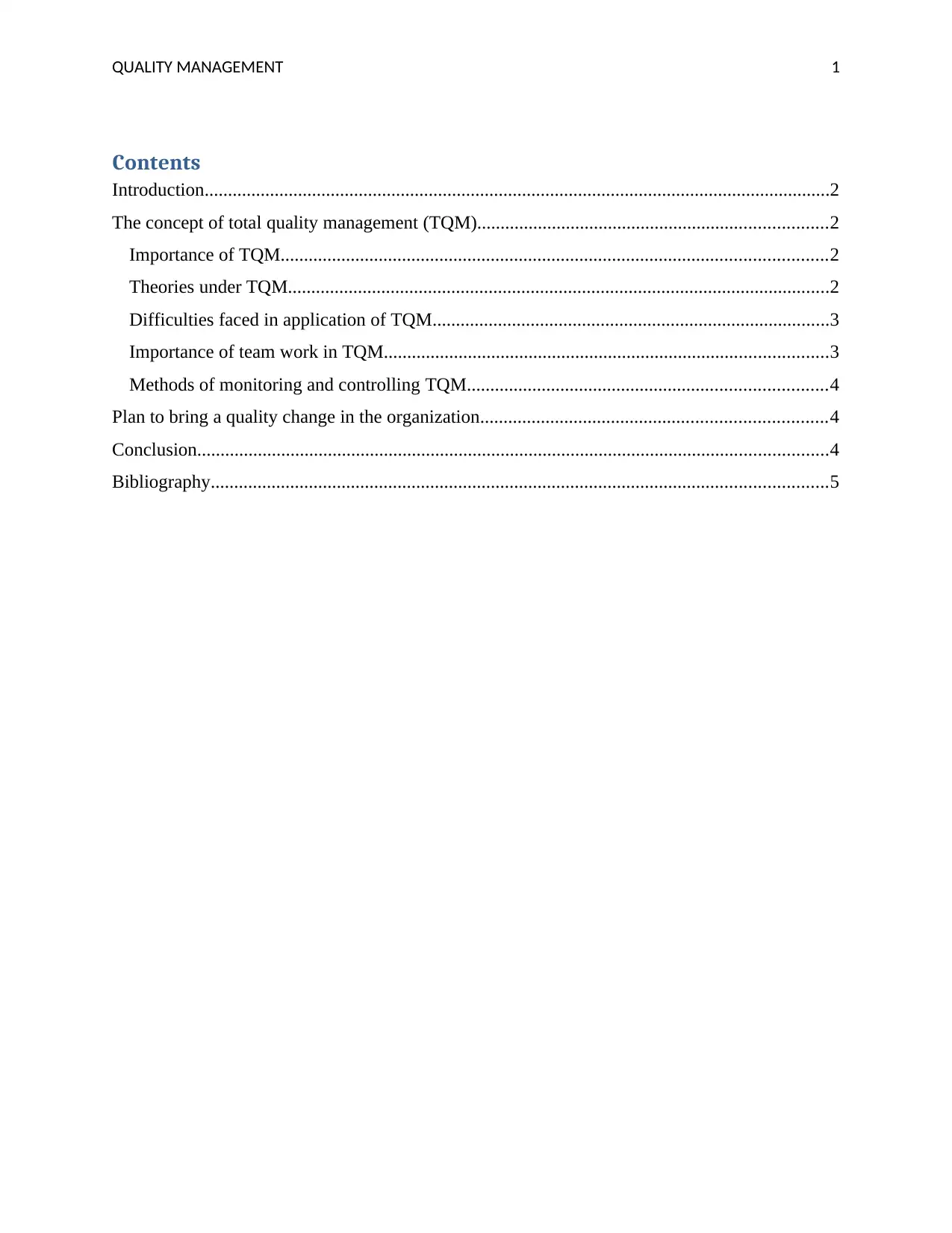
QUALITY MANAGEMENT 1
Contents
Introduction......................................................................................................................................2
The concept of total quality management (TQM)...........................................................................2
Importance of TQM.....................................................................................................................2
Theories under TQM....................................................................................................................2
Difficulties faced in application of TQM.....................................................................................3
Importance of team work in TQM...............................................................................................3
Methods of monitoring and controlling TQM.............................................................................4
Plan to bring a quality change in the organization..........................................................................4
Conclusion.......................................................................................................................................4
Bibliography....................................................................................................................................5
Contents
Introduction......................................................................................................................................2
The concept of total quality management (TQM)...........................................................................2
Importance of TQM.....................................................................................................................2
Theories under TQM....................................................................................................................2
Difficulties faced in application of TQM.....................................................................................3
Importance of team work in TQM...............................................................................................3
Methods of monitoring and controlling TQM.............................................................................4
Plan to bring a quality change in the organization..........................................................................4
Conclusion.......................................................................................................................................4
Bibliography....................................................................................................................................5
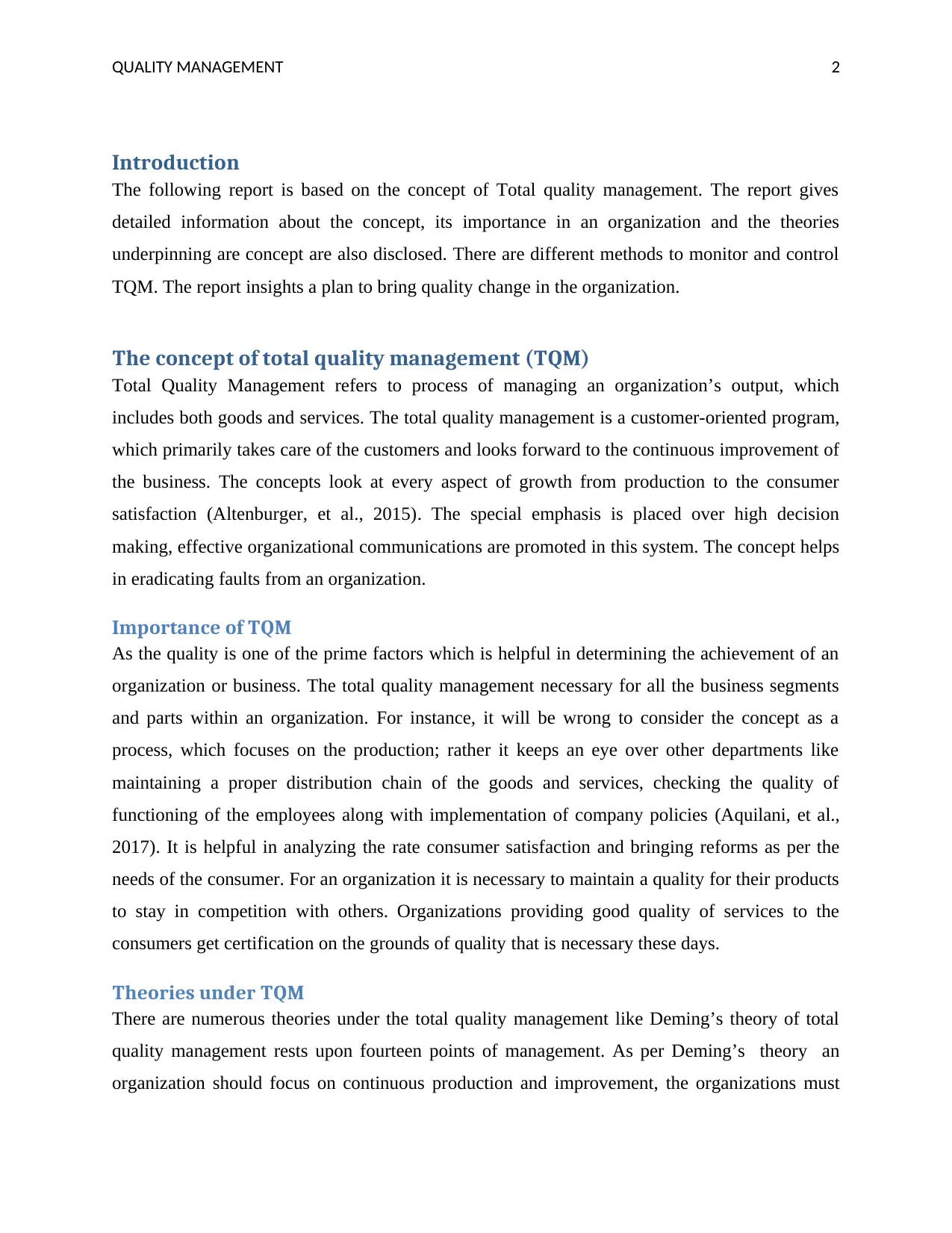
QUALITY MANAGEMENT 2
Introduction
The following report is based on the concept of Total quality management. The report gives
detailed information about the concept, its importance in an organization and the theories
underpinning are concept are also disclosed. There are different methods to monitor and control
TQM. The report insights a plan to bring quality change in the organization.
The concept of total quality management (TQM)
Total Quality Management refers to process of managing an organization’s output, which
includes both goods and services. The total quality management is a customer-oriented program,
which primarily takes care of the customers and looks forward to the continuous improvement of
the business. The concepts look at every aspect of growth from production to the consumer
satisfaction (Altenburger, et al., 2015). The special emphasis is placed over high decision
making, effective organizational communications are promoted in this system. The concept helps
in eradicating faults from an organization.
Importance of TQM
As the quality is one of the prime factors which is helpful in determining the achievement of an
organization or business. The total quality management necessary for all the business segments
and parts within an organization. For instance, it will be wrong to consider the concept as a
process, which focuses on the production; rather it keeps an eye over other departments like
maintaining a proper distribution chain of the goods and services, checking the quality of
functioning of the employees along with implementation of company policies (Aquilani, et al.,
2017). It is helpful in analyzing the rate consumer satisfaction and bringing reforms as per the
needs of the consumer. For an organization it is necessary to maintain a quality for their products
to stay in competition with others. Organizations providing good quality of services to the
consumers get certification on the grounds of quality that is necessary these days.
Theories under TQM
There are numerous theories under the total quality management like Deming’s theory of total
quality management rests upon fourteen points of management. As per Deming’s theory an
organization should focus on continuous production and improvement, the organizations must
Introduction
The following report is based on the concept of Total quality management. The report gives
detailed information about the concept, its importance in an organization and the theories
underpinning are concept are also disclosed. There are different methods to monitor and control
TQM. The report insights a plan to bring quality change in the organization.
The concept of total quality management (TQM)
Total Quality Management refers to process of managing an organization’s output, which
includes both goods and services. The total quality management is a customer-oriented program,
which primarily takes care of the customers and looks forward to the continuous improvement of
the business. The concepts look at every aspect of growth from production to the consumer
satisfaction (Altenburger, et al., 2015). The special emphasis is placed over high decision
making, effective organizational communications are promoted in this system. The concept helps
in eradicating faults from an organization.
Importance of TQM
As the quality is one of the prime factors which is helpful in determining the achievement of an
organization or business. The total quality management necessary for all the business segments
and parts within an organization. For instance, it will be wrong to consider the concept as a
process, which focuses on the production; rather it keeps an eye over other departments like
maintaining a proper distribution chain of the goods and services, checking the quality of
functioning of the employees along with implementation of company policies (Aquilani, et al.,
2017). It is helpful in analyzing the rate consumer satisfaction and bringing reforms as per the
needs of the consumer. For an organization it is necessary to maintain a quality for their products
to stay in competition with others. Organizations providing good quality of services to the
consumers get certification on the grounds of quality that is necessary these days.
Theories under TQM
There are numerous theories under the total quality management like Deming’s theory of total
quality management rests upon fourteen points of management. As per Deming’s theory an
organization should focus on continuous production and improvement, the organizations must
⊘ This is a preview!⊘
Do you want full access?
Subscribe today to unlock all pages.

Trusted by 1+ million students worldwide
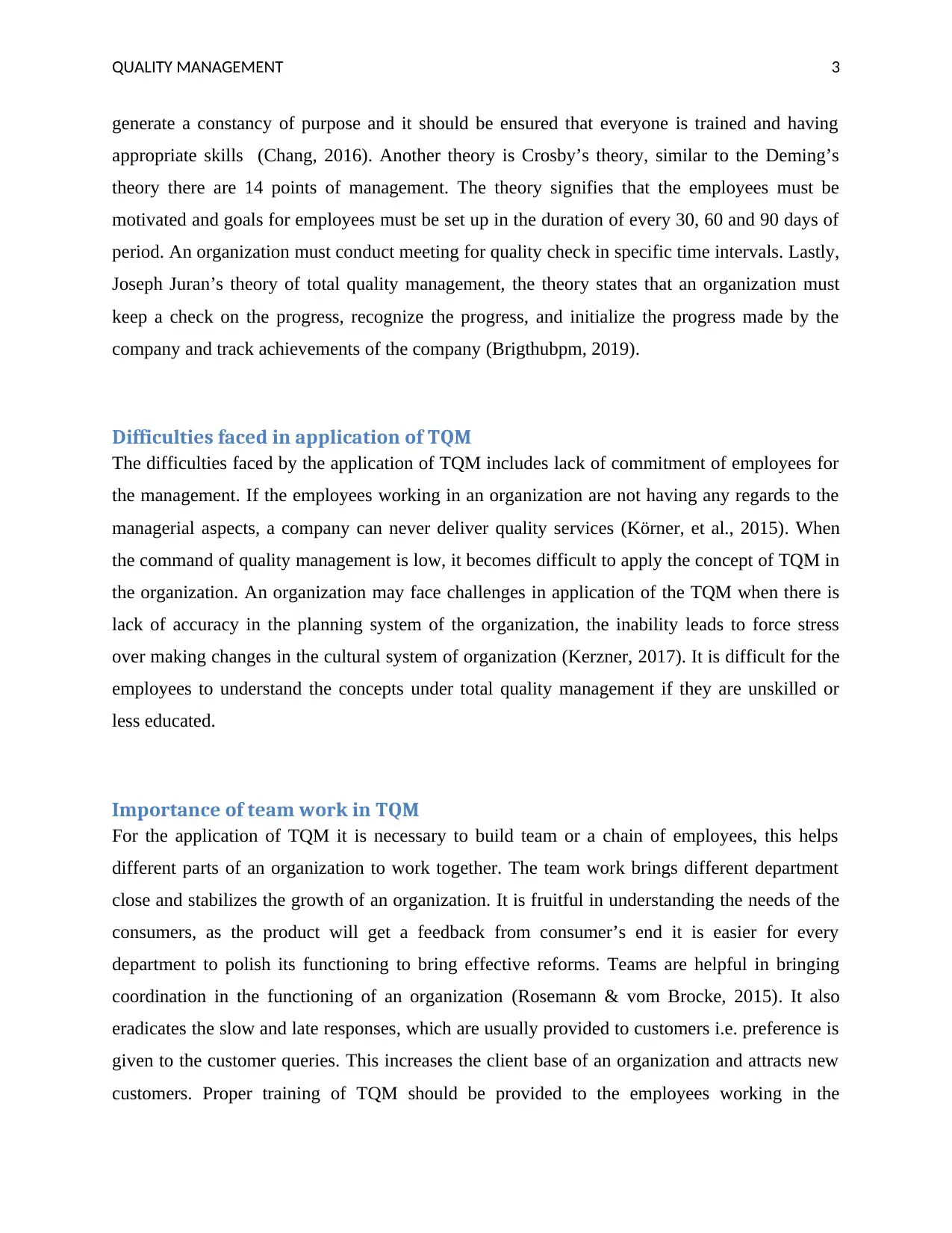
QUALITY MANAGEMENT 3
generate a constancy of purpose and it should be ensured that everyone is trained and having
appropriate skills (Chang, 2016). Another theory is Crosby’s theory, similar to the Deming’s
theory there are 14 points of management. The theory signifies that the employees must be
motivated and goals for employees must be set up in the duration of every 30, 60 and 90 days of
period. An organization must conduct meeting for quality check in specific time intervals. Lastly,
Joseph Juran’s theory of total quality management, the theory states that an organization must
keep a check on the progress, recognize the progress, and initialize the progress made by the
company and track achievements of the company (Brigthubpm, 2019).
Difficulties faced in application of TQM
The difficulties faced by the application of TQM includes lack of commitment of employees for
the management. If the employees working in an organization are not having any regards to the
managerial aspects, a company can never deliver quality services (Körner, et al., 2015). When
the command of quality management is low, it becomes difficult to apply the concept of TQM in
the organization. An organization may face challenges in application of the TQM when there is
lack of accuracy in the planning system of the organization, the inability leads to force stress
over making changes in the cultural system of organization (Kerzner, 2017). It is difficult for the
employees to understand the concepts under total quality management if they are unskilled or
less educated.
Importance of team work in TQM
For the application of TQM it is necessary to build team or a chain of employees, this helps
different parts of an organization to work together. The team work brings different department
close and stabilizes the growth of an organization. It is fruitful in understanding the needs of the
consumers, as the product will get a feedback from consumer’s end it is easier for every
department to polish its functioning to bring effective reforms. Teams are helpful in bringing
coordination in the functioning of an organization (Rosemann & vom Brocke, 2015). It also
eradicates the slow and late responses, which are usually provided to customers i.e. preference is
given to the customer queries. This increases the client base of an organization and attracts new
customers. Proper training of TQM should be provided to the employees working in the
generate a constancy of purpose and it should be ensured that everyone is trained and having
appropriate skills (Chang, 2016). Another theory is Crosby’s theory, similar to the Deming’s
theory there are 14 points of management. The theory signifies that the employees must be
motivated and goals for employees must be set up in the duration of every 30, 60 and 90 days of
period. An organization must conduct meeting for quality check in specific time intervals. Lastly,
Joseph Juran’s theory of total quality management, the theory states that an organization must
keep a check on the progress, recognize the progress, and initialize the progress made by the
company and track achievements of the company (Brigthubpm, 2019).
Difficulties faced in application of TQM
The difficulties faced by the application of TQM includes lack of commitment of employees for
the management. If the employees working in an organization are not having any regards to the
managerial aspects, a company can never deliver quality services (Körner, et al., 2015). When
the command of quality management is low, it becomes difficult to apply the concept of TQM in
the organization. An organization may face challenges in application of the TQM when there is
lack of accuracy in the planning system of the organization, the inability leads to force stress
over making changes in the cultural system of organization (Kerzner, 2017). It is difficult for the
employees to understand the concepts under total quality management if they are unskilled or
less educated.
Importance of team work in TQM
For the application of TQM it is necessary to build team or a chain of employees, this helps
different parts of an organization to work together. The team work brings different department
close and stabilizes the growth of an organization. It is fruitful in understanding the needs of the
consumers, as the product will get a feedback from consumer’s end it is easier for every
department to polish its functioning to bring effective reforms. Teams are helpful in bringing
coordination in the functioning of an organization (Rosemann & vom Brocke, 2015). It also
eradicates the slow and late responses, which are usually provided to customers i.e. preference is
given to the customer queries. This increases the client base of an organization and attracts new
customers. Proper training of TQM should be provided to the employees working in the
Paraphrase This Document
Need a fresh take? Get an instant paraphrase of this document with our AI Paraphraser
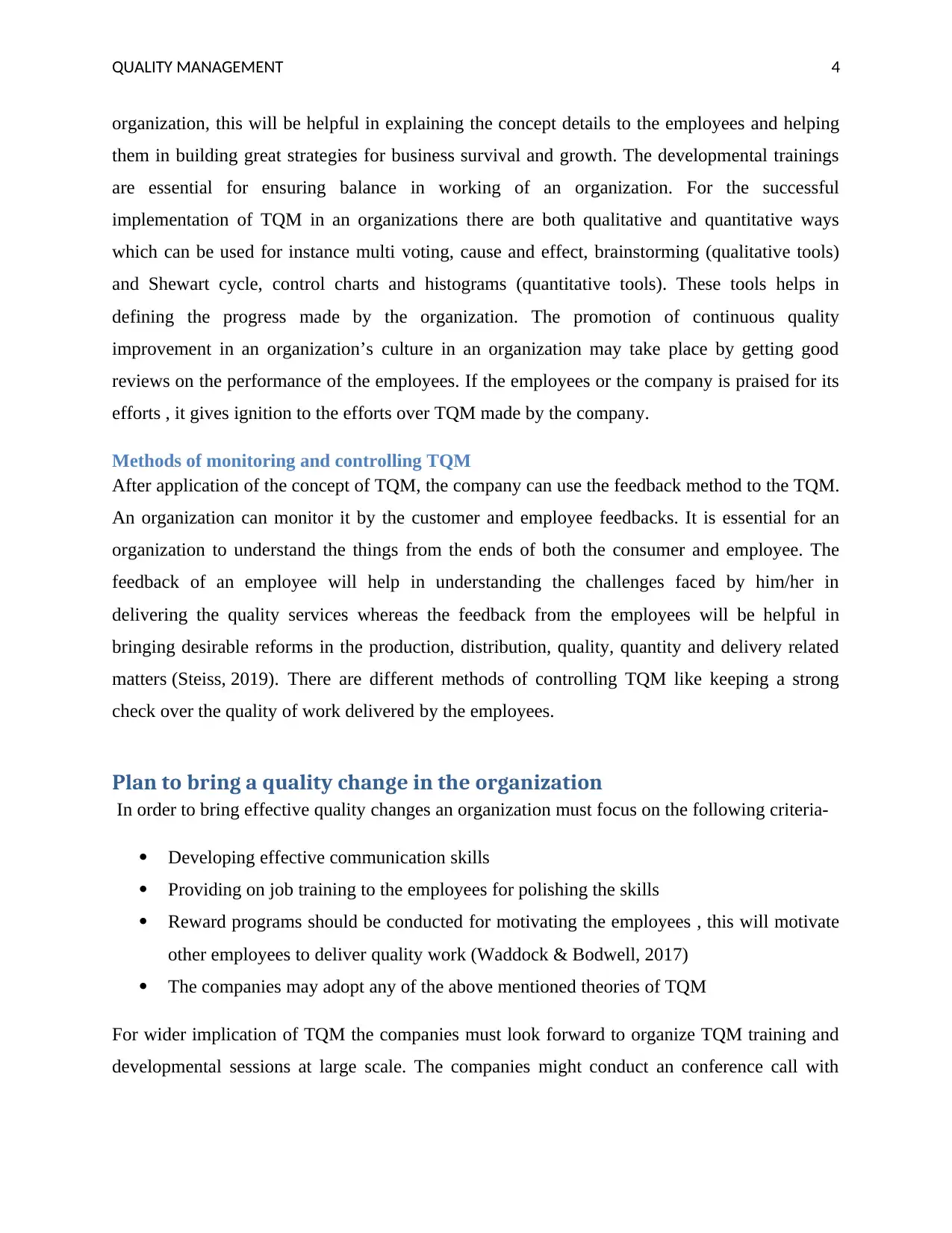
QUALITY MANAGEMENT 4
organization, this will be helpful in explaining the concept details to the employees and helping
them in building great strategies for business survival and growth. The developmental trainings
are essential for ensuring balance in working of an organization. For the successful
implementation of TQM in an organizations there are both qualitative and quantitative ways
which can be used for instance multi voting, cause and effect, brainstorming (qualitative tools)
and Shewart cycle, control charts and histograms (quantitative tools). These tools helps in
defining the progress made by the organization. The promotion of continuous quality
improvement in an organization’s culture in an organization may take place by getting good
reviews on the performance of the employees. If the employees or the company is praised for its
efforts , it gives ignition to the efforts over TQM made by the company.
Methods of monitoring and controlling TQM
After application of the concept of TQM, the company can use the feedback method to the TQM.
An organization can monitor it by the customer and employee feedbacks. It is essential for an
organization to understand the things from the ends of both the consumer and employee. The
feedback of an employee will help in understanding the challenges faced by him/her in
delivering the quality services whereas the feedback from the employees will be helpful in
bringing desirable reforms in the production, distribution, quality, quantity and delivery related
matters (Steiss, 2019). There are different methods of controlling TQM like keeping a strong
check over the quality of work delivered by the employees.
Plan to bring a quality change in the organization
In order to bring effective quality changes an organization must focus on the following criteria-
Developing effective communication skills
Providing on job training to the employees for polishing the skills
Reward programs should be conducted for motivating the employees , this will motivate
other employees to deliver quality work (Waddock & Bodwell, 2017)
The companies may adopt any of the above mentioned theories of TQM
For wider implication of TQM the companies must look forward to organize TQM training and
developmental sessions at large scale. The companies might conduct an conference call with
organization, this will be helpful in explaining the concept details to the employees and helping
them in building great strategies for business survival and growth. The developmental trainings
are essential for ensuring balance in working of an organization. For the successful
implementation of TQM in an organizations there are both qualitative and quantitative ways
which can be used for instance multi voting, cause and effect, brainstorming (qualitative tools)
and Shewart cycle, control charts and histograms (quantitative tools). These tools helps in
defining the progress made by the organization. The promotion of continuous quality
improvement in an organization’s culture in an organization may take place by getting good
reviews on the performance of the employees. If the employees or the company is praised for its
efforts , it gives ignition to the efforts over TQM made by the company.
Methods of monitoring and controlling TQM
After application of the concept of TQM, the company can use the feedback method to the TQM.
An organization can monitor it by the customer and employee feedbacks. It is essential for an
organization to understand the things from the ends of both the consumer and employee. The
feedback of an employee will help in understanding the challenges faced by him/her in
delivering the quality services whereas the feedback from the employees will be helpful in
bringing desirable reforms in the production, distribution, quality, quantity and delivery related
matters (Steiss, 2019). There are different methods of controlling TQM like keeping a strong
check over the quality of work delivered by the employees.
Plan to bring a quality change in the organization
In order to bring effective quality changes an organization must focus on the following criteria-
Developing effective communication skills
Providing on job training to the employees for polishing the skills
Reward programs should be conducted for motivating the employees , this will motivate
other employees to deliver quality work (Waddock & Bodwell, 2017)
The companies may adopt any of the above mentioned theories of TQM
For wider implication of TQM the companies must look forward to organize TQM training and
developmental sessions at large scale. The companies might conduct an conference call with
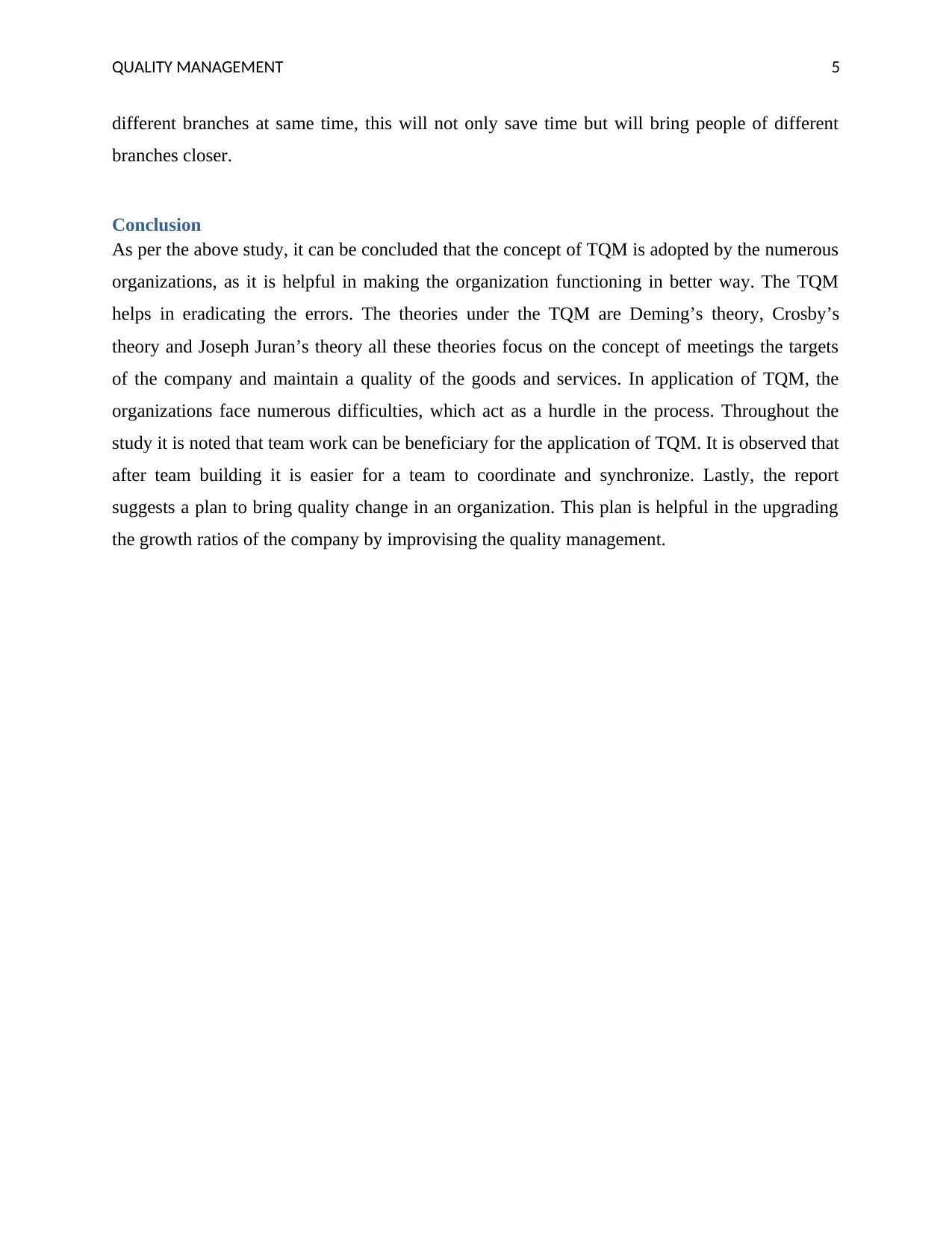
QUALITY MANAGEMENT 5
different branches at same time, this will not only save time but will bring people of different
branches closer.
Conclusion
As per the above study, it can be concluded that the concept of TQM is adopted by the numerous
organizations, as it is helpful in making the organization functioning in better way. The TQM
helps in eradicating the errors. The theories under the TQM are Deming’s theory, Crosby’s
theory and Joseph Juran’s theory all these theories focus on the concept of meetings the targets
of the company and maintain a quality of the goods and services. In application of TQM, the
organizations face numerous difficulties, which act as a hurdle in the process. Throughout the
study it is noted that team work can be beneficiary for the application of TQM. It is observed that
after team building it is easier for a team to coordinate and synchronize. Lastly, the report
suggests a plan to bring quality change in an organization. This plan is helpful in the upgrading
the growth ratios of the company by improvising the quality management.
different branches at same time, this will not only save time but will bring people of different
branches closer.
Conclusion
As per the above study, it can be concluded that the concept of TQM is adopted by the numerous
organizations, as it is helpful in making the organization functioning in better way. The TQM
helps in eradicating the errors. The theories under the TQM are Deming’s theory, Crosby’s
theory and Joseph Juran’s theory all these theories focus on the concept of meetings the targets
of the company and maintain a quality of the goods and services. In application of TQM, the
organizations face numerous difficulties, which act as a hurdle in the process. Throughout the
study it is noted that team work can be beneficiary for the application of TQM. It is observed that
after team building it is easier for a team to coordinate and synchronize. Lastly, the report
suggests a plan to bring quality change in an organization. This plan is helpful in the upgrading
the growth ratios of the company by improvising the quality management.
⊘ This is a preview!⊘
Do you want full access?
Subscribe today to unlock all pages.

Trusted by 1+ million students worldwide
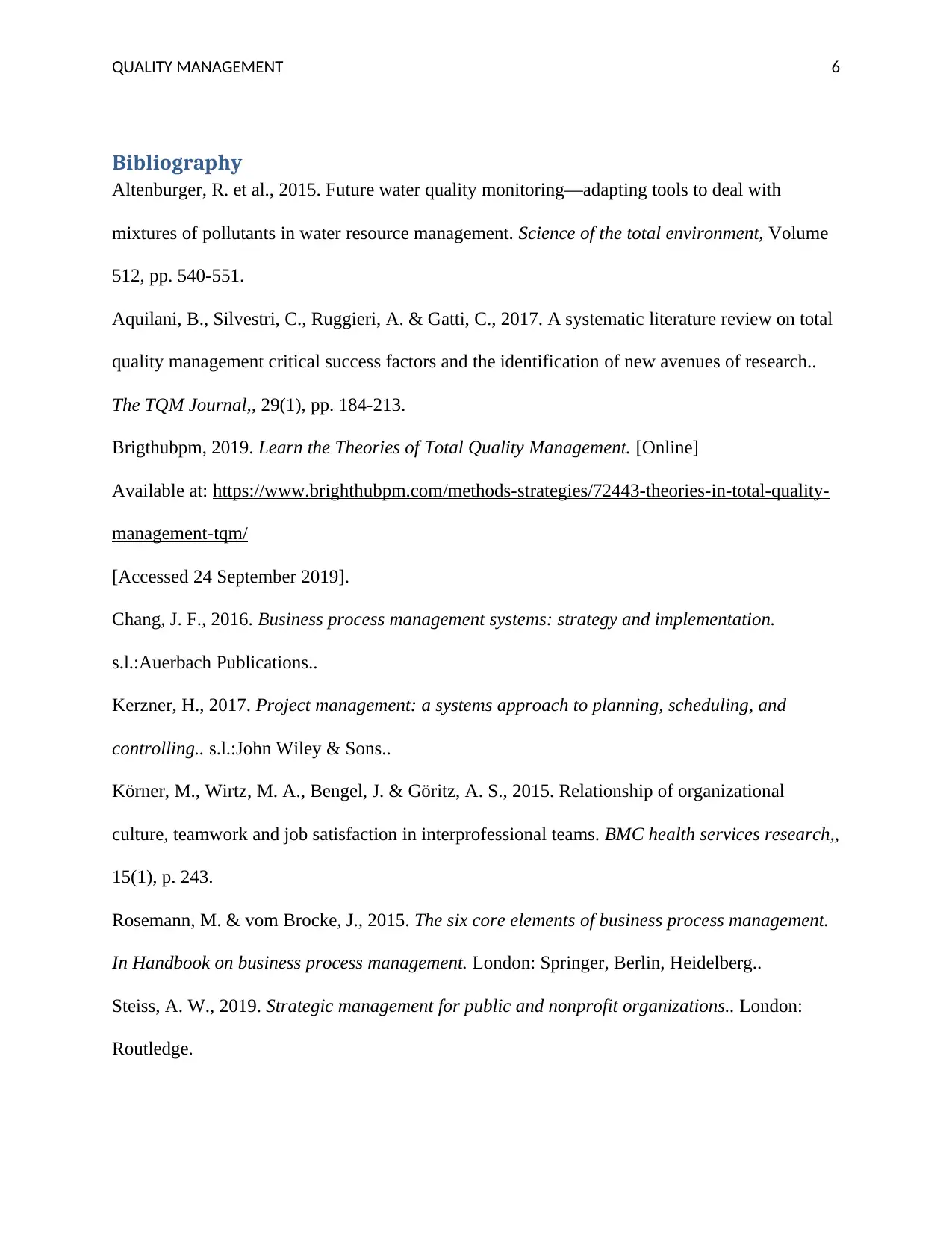
QUALITY MANAGEMENT 6
Bibliography
Altenburger, R. et al., 2015. Future water quality monitoring—adapting tools to deal with
mixtures of pollutants in water resource management. Science of the total environment, Volume
512, pp. 540-551.
Aquilani, B., Silvestri, C., Ruggieri, A. & Gatti, C., 2017. A systematic literature review on total
quality management critical success factors and the identification of new avenues of research..
The TQM Journal,, 29(1), pp. 184-213.
Brigthubpm, 2019. Learn the Theories of Total Quality Management. [Online]
Available at: https://www.brighthubpm.com/methods-strategies/72443-theories-in-total-quality-
management-tqm/
[Accessed 24 September 2019].
Chang, J. F., 2016. Business process management systems: strategy and implementation.
s.l.:Auerbach Publications..
Kerzner, H., 2017. Project management: a systems approach to planning, scheduling, and
controlling.. s.l.:John Wiley & Sons..
Körner, M., Wirtz, M. A., Bengel, J. & Göritz, A. S., 2015. Relationship of organizational
culture, teamwork and job satisfaction in interprofessional teams. BMC health services research,,
15(1), p. 243.
Rosemann, M. & vom Brocke, J., 2015. The six core elements of business process management.
In Handbook on business process management. London: Springer, Berlin, Heidelberg..
Steiss, A. W., 2019. Strategic management for public and nonprofit organizations.. London:
Routledge.
Bibliography
Altenburger, R. et al., 2015. Future water quality monitoring—adapting tools to deal with
mixtures of pollutants in water resource management. Science of the total environment, Volume
512, pp. 540-551.
Aquilani, B., Silvestri, C., Ruggieri, A. & Gatti, C., 2017. A systematic literature review on total
quality management critical success factors and the identification of new avenues of research..
The TQM Journal,, 29(1), pp. 184-213.
Brigthubpm, 2019. Learn the Theories of Total Quality Management. [Online]
Available at: https://www.brighthubpm.com/methods-strategies/72443-theories-in-total-quality-
management-tqm/
[Accessed 24 September 2019].
Chang, J. F., 2016. Business process management systems: strategy and implementation.
s.l.:Auerbach Publications..
Kerzner, H., 2017. Project management: a systems approach to planning, scheduling, and
controlling.. s.l.:John Wiley & Sons..
Körner, M., Wirtz, M. A., Bengel, J. & Göritz, A. S., 2015. Relationship of organizational
culture, teamwork and job satisfaction in interprofessional teams. BMC health services research,,
15(1), p. 243.
Rosemann, M. & vom Brocke, J., 2015. The six core elements of business process management.
In Handbook on business process management. London: Springer, Berlin, Heidelberg..
Steiss, A. W., 2019. Strategic management for public and nonprofit organizations.. London:
Routledge.
Paraphrase This Document
Need a fresh take? Get an instant paraphrase of this document with our AI Paraphraser
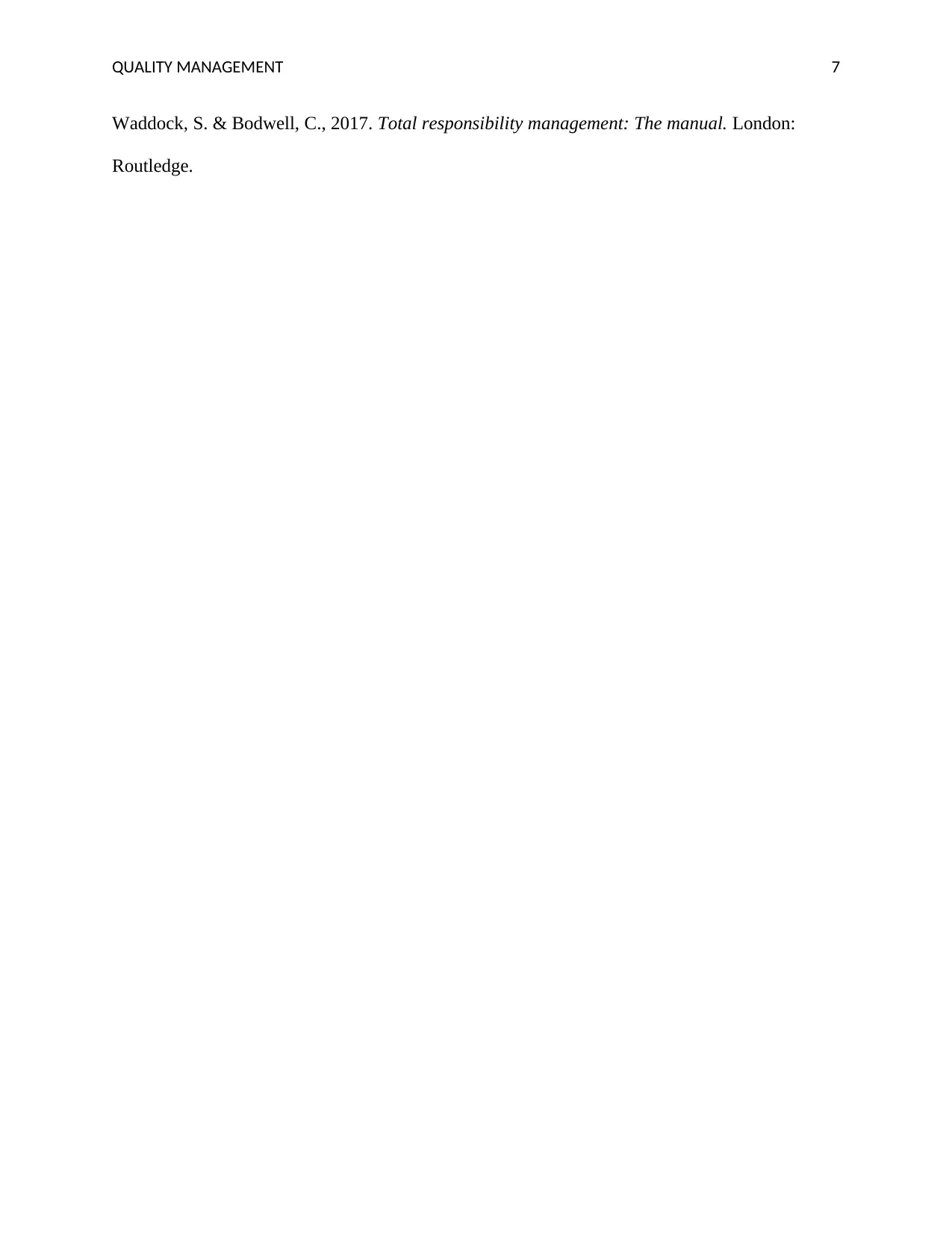
QUALITY MANAGEMENT 7
Waddock, S. & Bodwell, C., 2017. Total responsibility management: The manual. London:
Routledge.
Waddock, S. & Bodwell, C., 2017. Total responsibility management: The manual. London:
Routledge.
1 out of 8
Related Documents
Your All-in-One AI-Powered Toolkit for Academic Success.
+13062052269
info@desklib.com
Available 24*7 on WhatsApp / Email
![[object Object]](/_next/static/media/star-bottom.7253800d.svg)
Unlock your academic potential
Copyright © 2020–2025 A2Z Services. All Rights Reserved. Developed and managed by ZUCOL.





